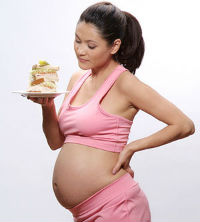Tips for Drinking and Eating During Labor
Childbirth is going to take a lot out of you, and it is important to keep yourself nourished so you will have the strength to get through it. Although labor is usually not a time when you have a big appetite, there are good times to get in a snack. Try these tips for drinking and eating during labor.
Eat Early
Eat to store up energy early in labor. When labor gets hard and heavy your stomach may not cooperate.
Eat Often
Grazing (eating small, frequent meals or snacks) is much more friendlier to a squeamish tummy than a big meal.
Eat High-Energy Food
During early labor, load your system with complex carbohydrates (grains and pasta) that are stomach-friendly and that will provide a slow, steady release of energy over the hours of hard work to follow. In later labor, nibble on or drink simple carbohydrates that leave the stomach quickly and provide quick bursts of energy: fruits, juices, honey. Some mothers nibble on energy bars during labor.
Choose Stomach-Friendly Foods When Eating During Labor
Some mothers experience nausea and find drinking and eating during labor unappetizing. Nevertheless, they need to eat. So bring along foods and drinks that were proven favorites during your early, nauseous months of pregnancy. Foods you tolerated then are the ones you are most likely to be able to digest now. Avoid fatty and fried foods, gassy foods and carbonated beverages–there is enough work going on inside you without making the intestines labor, too.
Drink, Drink and Drink
Avoid becoming dehydrated, which depletes your energy, upsets your body’s physiology and slows labor. Pre-load your tank with at least 8 ounces of water per hour in early labor, and sip between contractions. Be sure to bring at least two water bottles with your favorite fluid to the hospital; place them within easy reach at your bedside. Many mothers in our practice have used a time-tested recipe they call “laborade,” which is a healthy version of the familiar drink of athletes. It provides carbohydrates, electrolytes and minerals to help keep your body chemistry balanced. Mix up some “laborade” with this recipe:
- 1/3 cup lemon juice
- 1/3 cup honey
- 1/4 – 1/2 tsp. Salt
- 1/4 tsp. baking soda
- 1-2 calcium tablets, crushed
Add enough water to make one quart. You can add an additional eight ounces of water for a milder flavor, or you can flavor this blend with your favorite juice.
Consider Intravenous “Feedings”
If you are too nauseated for drinking or eating during labor and your practitioner feels that you are becoming dehydrated, he or she may recommend giving you intravenous fluids. This can perk up a stalled labor or an exhausted mom. An additional benefit: more fluids mean more trips to the bathroom, which, because of the walking and squatting, are themselves, labor stimulators.




